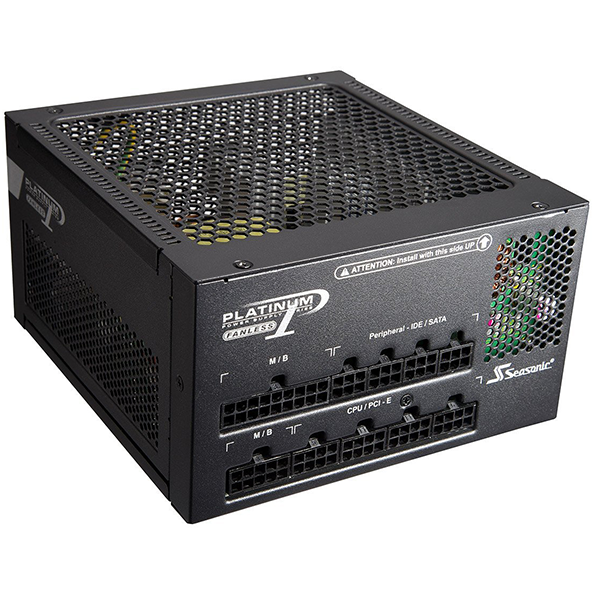Super Flower Leadex Gold 550W PSU Review
Super Flower has made quite an impact on the PSU market. Its Leadex platform enjoys huge popularity, both under SF's brand name and other companies like EVGA. The newest Leadex Gold-rated PSU with 550W capacity is on our test bench today.
Why you can trust Tom's Hardware
Load Regulation, Hold-Up Time And Inrush Current
To learn more about our PSU tests and methodology, please check out How We Test Power Supply Units.
Primary Rails And 5VSB Load Regulation
Load Regulation testing is detailed here.
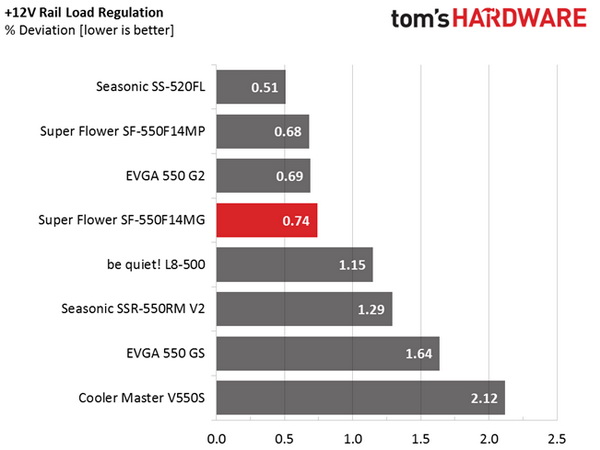
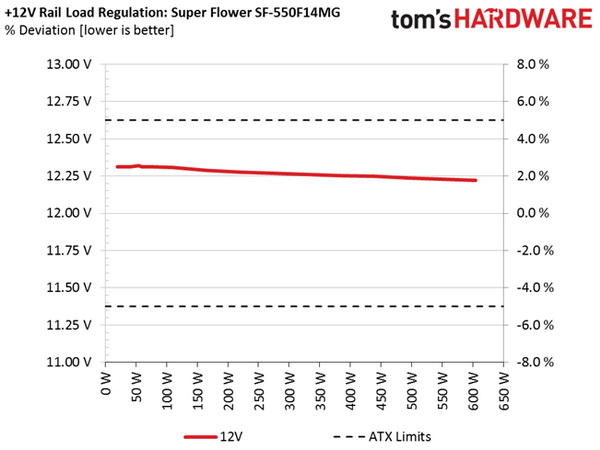

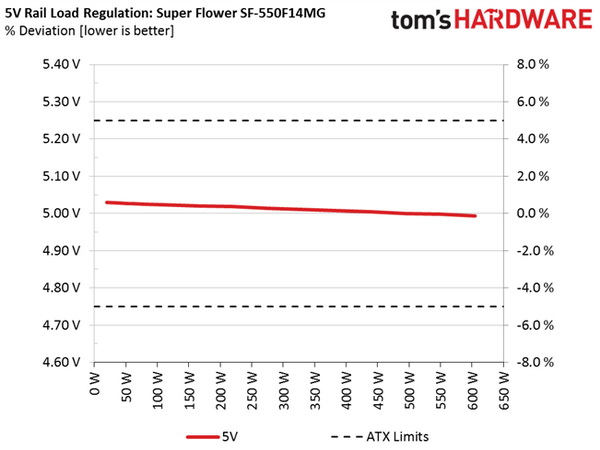

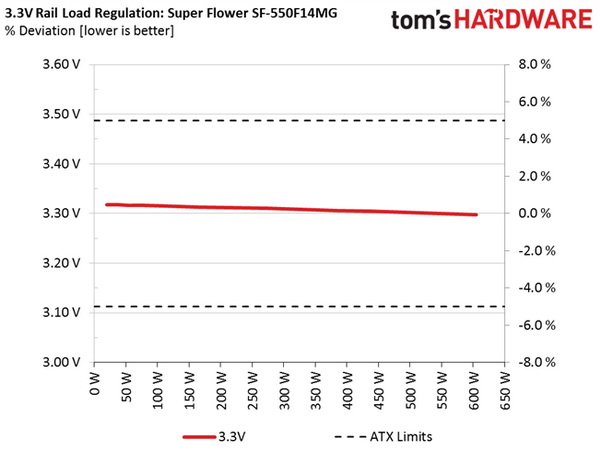
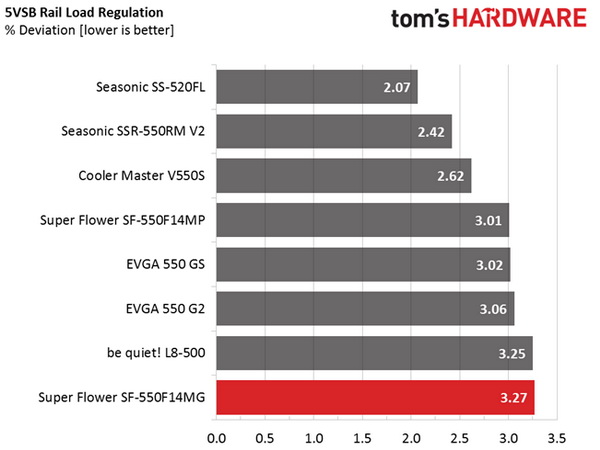
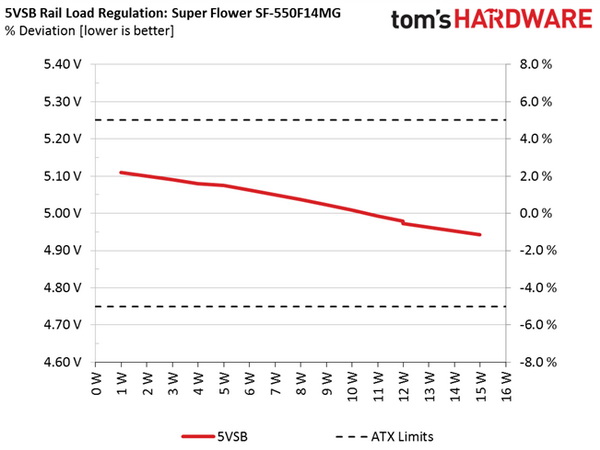
Hold-Up Time
Our hold-up time tests are described in detail here.
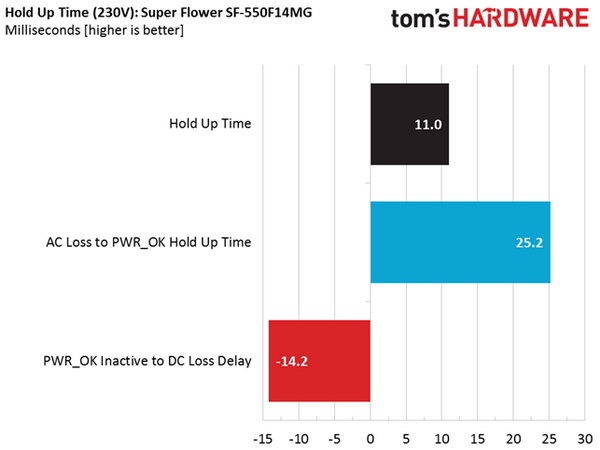

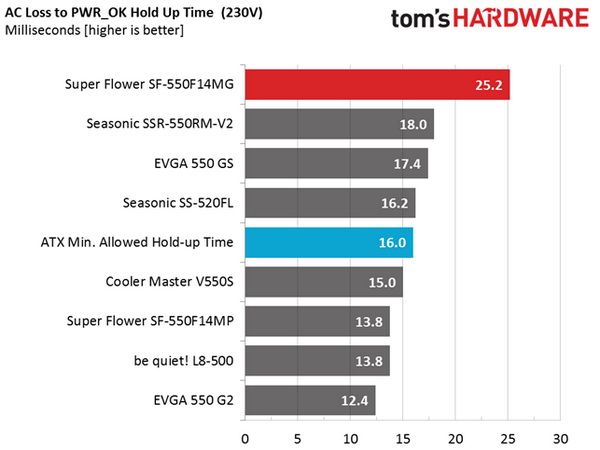
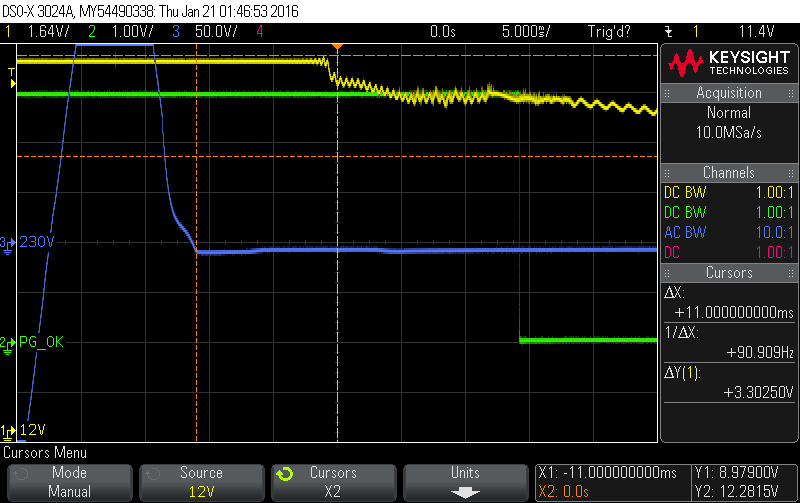
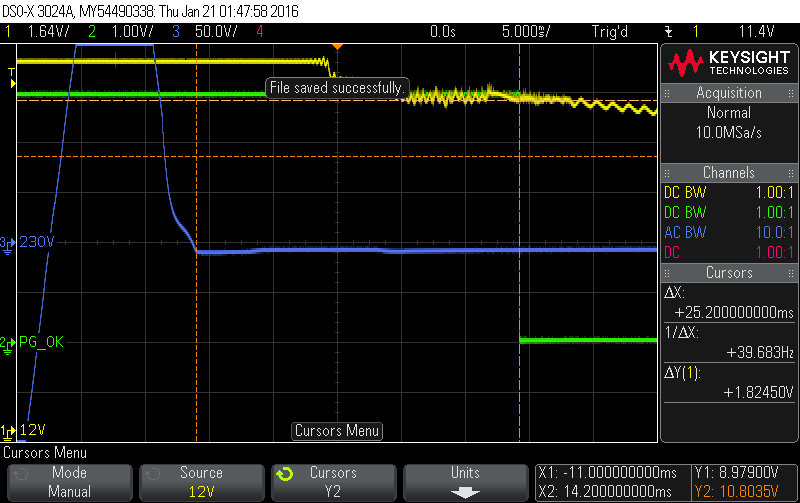
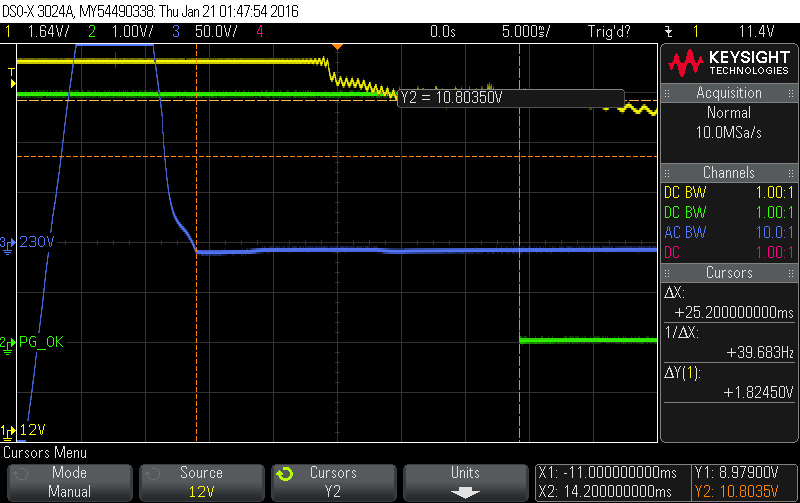
The hold-up time tests don't go well. Not only is the measured hold-up less than 16ms (the ATX spec's minimum), but the Power_OK signal drops after, and not before, the PSU's rails go out of spec. This means that your motherboard gets a false power-good signal from the PSU. Indeed, we measured the +12V rail floating at around 10.8V when Power_OK dropped to zero. This is a very low voltage level that applies lots of stress to the voltage regulators of components fed by +12V.
In a high-end PSU like this one, we didn't expect such nasty behavior. We have to admit that we're very disappointed by Super Flower's decision to drop the power-good signal so late, which is probably done to give the false impression that the hold-up time lasts longer. By the end of our review, this is going to cost to this PSU a lot of performance points. Whereas it might have received an award for performance, there's no way it will now.
Inrush Current
For details on our inrush current testing, please click here.
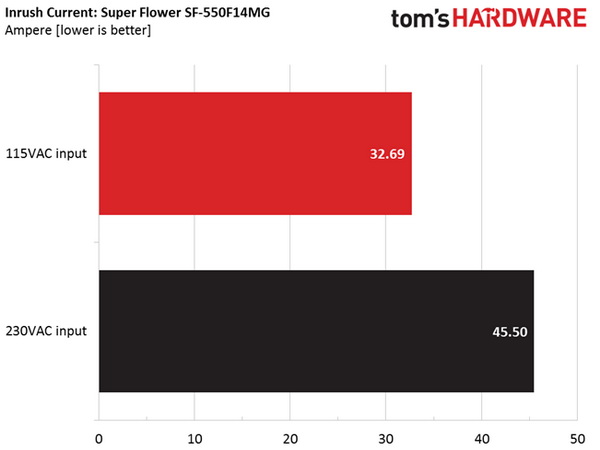

The measured inrush current was normal with both inputs (115V and 230V).
Get Tom's Hardware's best news and in-depth reviews, straight to your inbox.
Load Regulation And Efficiency Measurements
The first set of tests explores voltage rail stability and efficiency. The applied load equals (approximately) 10 to 110 percent of the supply's maximum in increments of 10 percentage points.
We conducted two additional tests. During the first, we stressed the two minor rails (5V and 3.3V) with a high load, while the load at +12V was only 0.10A. This test reveals whether a PSU is Haswell-ready or not. In the second test, we determined the maximum load the +12V rail could handle with minimal load on the minor rails.
| Test # | 12V | 5V | 3.3V | 5VSB | DC/AC (Watts) | Efficiency | Fan Speed (RPM) | Noise (dB[A]) | Temps (In/Out) | PF/AC Volts |
|---|---|---|---|---|---|---|---|---|---|---|
| 1 | 2.693A | 1.988A | 1.990A | 0.983A | 54.76 | 83.30% | 0 | 0 | 48.73 °C | 0.950 |
| 12.321V | 5.026V | 3.316V | 5.075V | 65.74 | 47.34 °C | 115.0V | ||||
| 2 | 6.411A | 2.979A | 2.984A | 1.186A | 109.76 | 87.45% | 1100 | 40.7 | 37.60 °C | 0.968 |
| 12.307V | 5.023V | 3.315V | 5.062V | 125.51 | 42.53 °C | 115.0V | ||||
| 3 | 10.482A | 3.486A | 3.499A | 1.384A | 164.89 | 88.91% | 1060 | 38.3 | 37.69 °C | 0.980 |
| 12.289V | 5.020V | 3.313V | 5.050V | 185.45 | 42.76 °C | 115.0V | ||||
| 4 | 14.546A | 3.983A | 3.984A | 1.585A | 219.76 | 89.58% | 1080 | 39.7 | 39.02 °C | 0.986 |
| 12.278V | 5.018V | 3.312V | 5.037V | 245.32 | 45.13 °C | 115.1V | ||||
| 5 | 18.282A | 4.978A | 4.982A | 1.791A | 274.75 | 89.67% | 1110 | 40.9 | 39.88 °C | 0.989 |
| 12.269V | 5.014V | 3.310V | 5.023V | 306.39 | 47.10 °C | 115.1V | ||||
| 6 | 22.017A | 5.983A | 5.984A | 1.996A | 329.74 | 89.47% | 1140 | 39.8 | 40.74 °C | 0.991 |
| 12.262V | 5.010V | 3.308V | 5.008V | 368.55 | 49.20 °C | 115.1V | ||||
| 7 | 25.760A | 6.993A | 6.986A | 2.199A | 384.75 | 88.88% | 1165 | 38.7 | 41.75 °C | 0.992 |
| 12.254V | 5.007V | 3.306V | 4.993V | 432.91 | 51.54 °C | 115.1V | ||||
| 8 | 29.501A | 7.994A | 7.989A | 2.407A | 439.68 | 88.37% | 1230 | 40.4 | 42.77 °C | 0.993 |
| 12.247V | 5.004V | 3.304V | 4.979V | 497.55 | 54.07 °C | 115.1V | ||||
| 9 | 33.685A | 8.497A | 8.509A | 2.410A | 494.77 | 87.70% | 1260 | 39.6 | 44.01 °C | 0.994 |
| 12.237V | 5.000V | 3.302V | 4.973V | 564.18 | 56.72 °C | 115.1V | ||||
| 10 | 37.607A | 9.010A | 9.001A | 3.032A | 549.66 | 87.03% | 1325 | 40.7 | 45.84 °C | 0.994 |
| 12.230V | 4.998V | 3.300V | 4.943V | 631.58 | 59.43 °C | 115.1V | ||||
| 11 | 42.136A | 9.012A | 9.005A | 3.036A | 604.64 | 86.38% | 1370 | 42.4 | 47.19 °C | 0.994 |
| 12.221V | 4.994V | 3.298V | 4.938V | 699.97 | 62.96 °C | 115.1V | ||||
| CL1 | 0.100A | 13.015A | 13.005A | 0.004A | 109.56 | 81.42% | 1310 | 40.0 | 45.24 °C | 0.970 |
| 12.333V | 5.008V | 3.316V | 5.084V | 134.56 | 49.73 °C | 115.1V | ||||
| CL2 | 45.792A | 1.002A | 1.003A | 1.002A | 572.54 | 87.71% | 1310 | 40.0 | 46.85 °C | 0.994 |
| 12.211V | 5.008V | 3.301V | 5.035V | 652.79 | 61.08 °C | 115.1V |
Load regulation is super tight on all rails except for 5VSB, which isn't particularly important as long as it meets the ATX specification's requirements. We also noticed that Super Flower improved this PSU's semi-passive mode. The fan doesn't stay inactive for long, compromising the lifetime of heat-sensitive components like electrolytic capacitors.
Since this PSU doesn't exclusively use Japanese capacitors, we were relieved to see the fan spinning during the 20 percent load test. Once the fan is engaged and the temperature is high, you will probably hear it, especially if you are sensitive to noise. On top of that, we noticed some bearing and vibration noise thanks to our super-sensitive sound analyzer (not our ears). This is why, in some of our measurements, we got higher noise levels compared to readings where the fan was actually spinning faster.
The PSU clears the 80 PLUS Gold spec's 20 percent and full load requirements by registering over 87 percent efficiency, However, it falls a little short in the 50 percent load test. Nonetheless, we give it a pass since we conduct our tests in much higher temperatures than the 80 PLUS organization. In general, this unit fares admirably, but it definitely isn't among the most efficient Gold-rated PSUs we've ever tested.
Current page: Load Regulation, Hold-Up Time And Inrush Current
Prev Page A Look Inside And Component Analysis Next Page Efficiency, Temperature And Noise
Aris Mpitziopoulos is a contributing editor at Tom's Hardware, covering PSUs.
-
blazorthon Granted the EPS and PCIe wires don't see very high current in most situations (especially the EPS with Haswell or Skylake CPUs), I hardly ever see other PSUs using thinner gauge wires, so I can't imagine it saving enough money to be worth going thinner than the recommended 18 gauge wires most other PSUs have regardless of capacity.Reply -
Quaddro Why crapxon?Reply
I'm tired to see bulged crapxon..
If this one use jap caps, it'll be absolutely perfect.. -
mctylr ReplyUnfortunately, the bridge rectifier's markings are on its hidden side, and we try to avoid desoldering these type of parts since they are extra sensitive to increased heat
Huh? Since when are bridge rectifiers particularly heat sensitive? I would say that bridge rectifiers are not worth the hassle to desolder, unless you suspect it was an underrated part.
APFC controller is an NCP1653A provided by ON Semiconductor. It's installed on a small vertical PCB and is covered by insulation tape in order to decrease EMI noise.
That looks like paper and vinyl / PVC electrical tape wrapped around the vertical PCB, which provides electrical isolation only, I doubt it would make measurable difference in EMI. -
Aris_Mp According to my experience so far they are, unfortunately.Reply
This provides some EMI protection. There is no need for electrical insulation on this board. As for the degree or EMI protection I can examine this with my EMC probes (once I find the time to do it). -
Andi lim this review said uses a half-bridge topology, I only see one main capacitor. half bridge usualy uses 2 main cap and 2 main switcher right ?Reply -
Aris_Mp the number of APFC caps has nothing to do with the primary topology. However yes half-bridge uses 2 switchers.Reply -
Andi lim You are right, this is half bridge with LLC series resonant converter, nothing wrong with the primary capacitor.Reply


